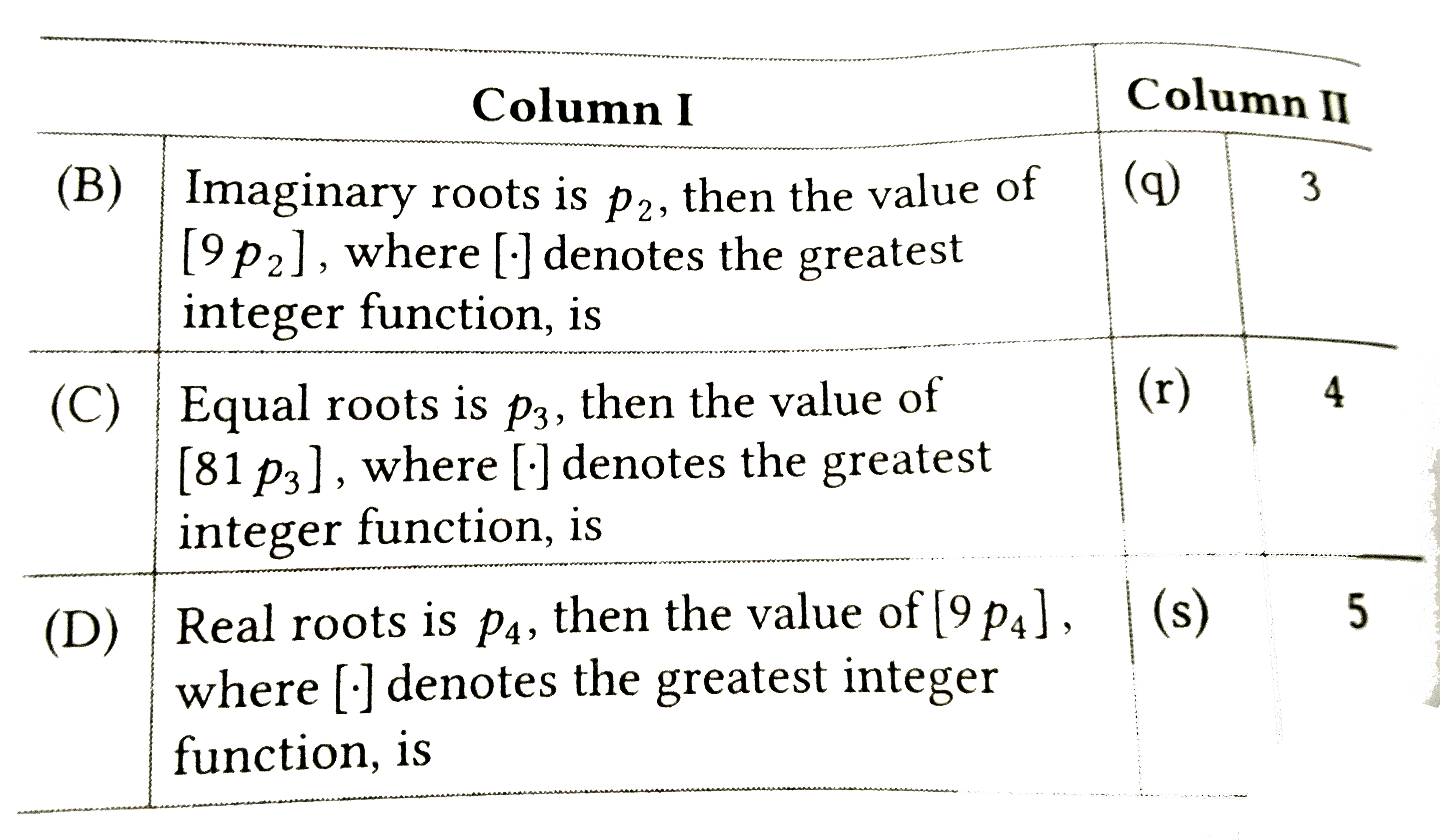Two numbers a and b are chosen at random from the set {1,2,3,..,3n}. The probability that is divisible by 3, is
The correct Answer is:D
To solve the problem of finding the probability that a3+b3 is divisible by 3 when two numbers a and b are chosen at random from the set {1,2,3,…,3n}, we can follow these steps:
Step 1: Understand the Problem
We need to find the probability that a3+b3 is divisible by 3. We know from number theory that a3+b3 can be expressed as (a+b)(a2−ab+b2). For a3+b3 to be divisible by 3, a+b must be divisible by 3.
Step 2: Group the Numbers
We can categorize the numbers in the set {1,2,3,…,3n} based on their remainders when divided by 3:
- Group G1: Numbers that are 0mod3 (i.e., divisible by 3): {3,6,9,…,3n}
- Group G2: Numbers that are 1mod3: {1,4,7,…,3n−2}
- Group G3: Numbers that are 2mod3: {2,5,8,…,3n−1}
Each group contains n elements.
Step 3: Identify Favorable Outcomes
Now, we need to find the combinations of a and b such that a+b is divisible by 3. This can happen in the following cases:
1. Both a and b are from G1.
2. One number is from G2 and the other from G3.
Case 1: Both from G1
The number of ways to choose 2 numbers from G1 (which has n elements) is given by:
(n2)
Case 2: One from G2 and one from G3
The number of ways to choose 1 number from G2 and 1 number from G3 is:
(n1)×(n1)=n×n=n2
Step 4: Total Favorable Outcomes
The total number of favorable outcomes is:
Total Favorable Outcomes=(n2)+n2
Step 5: Total Outcomes
The total number of ways to choose 2 numbers from the set of 3n numbers is:
(3n2)
Step 6: Calculate the Probability
The probability P that a3+b3 is divisible by 3 is given by:
P=Total Favorable OutcomesTotal Outcomes=(n2)+n2(3n2)
Step 7: Simplify the Expression
Calculating the binomial coefficients:
(n2)=n(n−1)2,(3n2)=3n(3n−1)2
Substituting these into the probability expression:
P=n(n−1)2+n23n(3n−1)2=n(n−1)+2n23n(3n−1)=3n2−n3n(3n−1)
Step 8: Final Calculation
Simplifying further:
P=n(3n−1)3n(3n−1)=13
Thus, the final probability that a3+b3 is divisible by 3 is:
13
We need to find the probability that a3+b3 is divisible by 3. We know from number theory that a3+b3 can be expressed as (a+b)(a2−ab+b2). For a3+b3 to be divisible by 3, a+b must be divisible by 3.
We can categorize the numbers in the set {1,2,3,…,3n} based on their remainders when divided by 3:
- Group G1: Numbers that are 0mod3 (i.e., divisible by 3): {3,6,9,…,3n}
- Group G2: Numbers that are 1mod3: {1,4,7,…,3n−2}
- Group G3: Numbers that are 2mod3: {2,5,8,…,3n−1}
Now, we need to find the combinations of a and b such that a+b is divisible by 3. This can happen in the following cases:
1. Both a and b are from G1.
2. One number is from G2 and the other from G3.
The number of ways to choose 2 numbers from G1 (which has n elements) is given by:
(n2)
The number of ways to choose 1 number from G2 and 1 number from G3 is:
(n1)×(n1)=n×n=n2
The total number of favorable outcomes is:
Total Favorable Outcomes=(n2)+n2
The total number of ways to choose 2 numbers from the set of 3n numbers is:
(3n2)
The probability P that a3+b3 is divisible by 3 is given by:
P=Total Favorable OutcomesTotal Outcomes=(n2)+n2(3n2)
Calculating the binomial coefficients:
(n2)=n(n−1)2,(3n2)=3n(3n−1)2
Substituting these into the probability expression:
P=n(n−1)2+n23n(3n−1)2=n(n−1)+2n23n(3n−1)=3n2−n3n(3n−1)
Simplifying further:
P=n(3n−1)3n(3n−1)=13
13
Topper's Solved these Questions
- PROBABILITY Book:OBJECTIVE RD SHARMA ENGLISHChapter:PROBABILITY Exercise:Section I - Solved Mcqs
Explore 126 Videos
- PROBABILITY Book:OBJECTIVE RD SHARMA ENGLISHChapter:PROBABILITY Exercise:Section- II (Assertion -Reason Types MCQs)
Explore 15 Videos
- PERMUTATIONS AND COMBINATIONSBook:OBJECTIVE RD SHARMA ENGLISHChapter:PERMUTATIONS AND COMBINATIONSExercise:Chapter Test
Explore 60 Videos
- QUADRATIC EXPRESSIONS AND EQUATIONS Book:OBJECTIVE RD SHARMA ENGLISHChapter:QUADRATIC EXPRESSIONS AND EQUATIONS Exercise:Chapter Test
Explore 50 Videos
Similar Questions
Two natural numbers x and y are chosen at random from the set {1,2,3,4,...3n}. find the probability that x2−y2 is divisible by 3.
View SolutionIf two distinct numbers m and n are chosen at random form the set {1, 2, 3, …, 100}, then find the probability that 2m+2n+1 is divisible by 3.
View SolutionTwo numbers a and b are chosen at random from the set {1,2,3,4,...,0} with replacement. The probability that the equation x2+√2(a−b)x+b=0 has


View SolutionLet n=10λ+r, where λ,r∈N,0≤r≤9. A number a is chosen at random from the set {1, 2, 3,…, n} and let pn denote the probability that (a2−1) is divisible by 10.
If r=0, then npn equals
View SolutionLet n=10λ+r,whereλ,r∈N,0≤r≤9. A number a is chosen at random from the set {1, 2, 3,…, n} and let pn denote the probability that (a2−1) is divisible by 10.
If r=9, then npn equals
View SolutionThree distinct numbers are chosen at random from the first 15 natural numbers. The probability that the sum will be divisible by 3 is
View SolutionTwo number aandb aer chosen at random from the set of first 30 natural numbers. Find the probability that a2−b2 is divisible by 3.
View SolutionTwo natural numbers x and y are chosen at random. What is the probability that x2+y2 is divisible by 5?
View SolutionFour numbers are chosen at random from {1,2,3,......,40}. The probability that they are not consecutive is
View SolutionAn integer is chosen at random from 1 to 50. Find the probability that the number is:
divisible by 5
View Solution